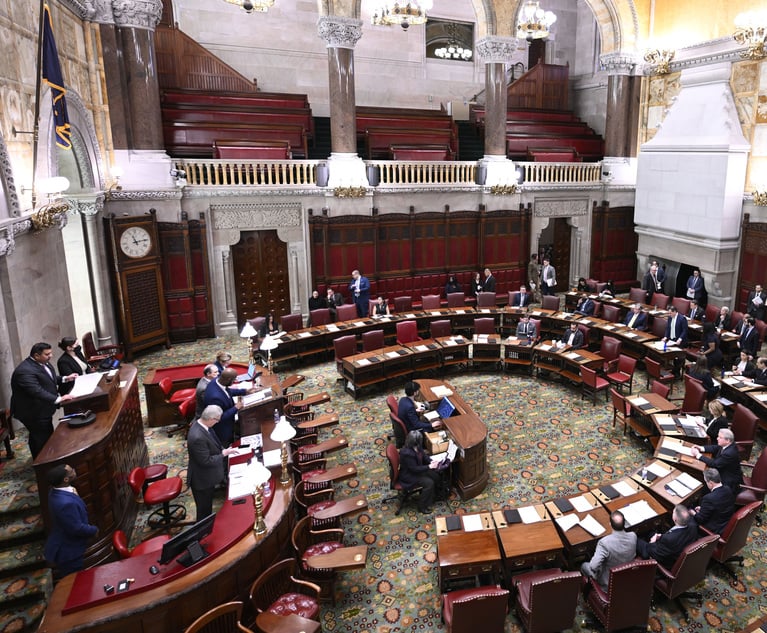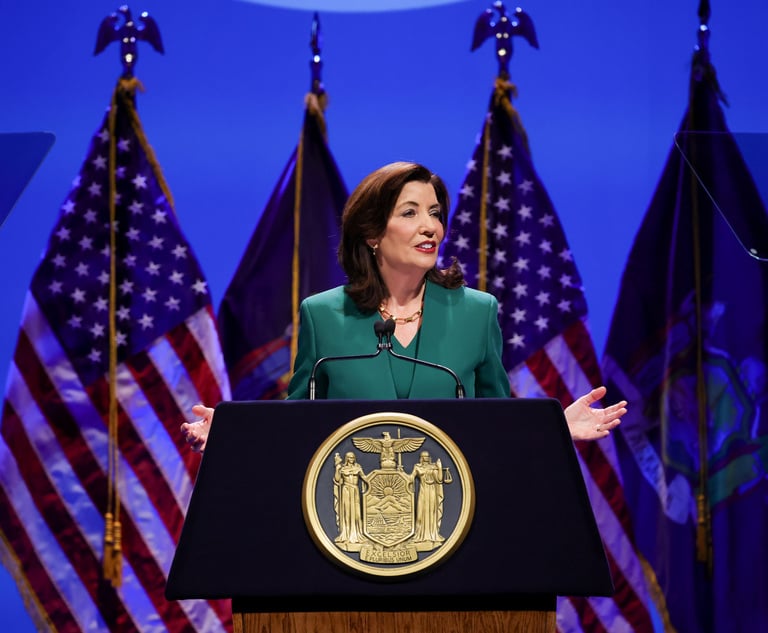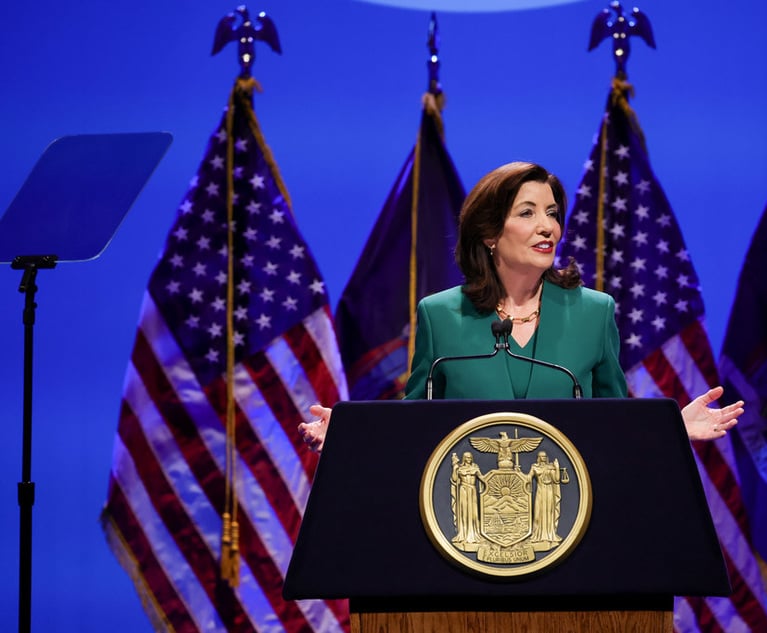Albany's Still-To-Do Election Reforms
In their Government and Election Law column, Jerry H. Goldfeder and Myrna Pérez note that Albany has taken some “exciting steps at reforming New York's election laws,” however two critical reforms remain to be passed: Automatic Voter Registration (AVR), and rights restoration for all citizens living in the community with convictions in their past.
May 09, 2019 at 11:30 AM
7 minute read
 Jerry H. Goldfeder and Myrna Pérez
Jerry H. Goldfeder and Myrna Pérez
In our previous column we noted that Albany has taken some exciting steps at reforming New York's election laws, but its work is not done. Two critical reforms remain to be passed: Automatic Voter Registration (AVR), and rights restoration for all citizens living in the community with convictions in their past. For the first time in many years, there appears to be sufficient political will to make New York a leader on election reform. Yet, further efforts seem to be stalled. Given the notoriously low turnout in New York's elections, it would be a shame to not move ahead on reforms as simple and significant as AVR and rights restoration.
To recap where we are: early voting, pre-registration, online registration, polling hour expansion, and registration portability have been passed. The first step of the process has been taken to amend the state constitution to enact same-day registration and no-excuse absentee voting. Legislation has also been enacted that promises campaign finance reform. That said, restoring rights for persons with past criminal convictions living in the community and AVR remain on the table.
AVR
Automatic voter registration can have a transformative impact in New York. In the last four years, 15 states plus the District of Columbia have adopted AVR. Lawmakers in 22 more states across the country have introduced AVR legislation this session.
Automatic voter registration reverses the traditional way of registering voters in two simple ways. The first is that AVR switches the voter registration opportunity from one that is “opt-in” (where applicants have to affirmatively request to register to vote) to “opt-out” (where eligible citizens are registered to vote unless they affirmatively decline to register). No one is registered against their will. Everyone is given a clear opportunity to opt-out. An opt-out approach capitalizes on how our brains work—behavioral scientists have shown that our brains are hard-wired to choose the default option presented to us.
The second is that it transfers voter registration information from government agencies to election officials electronically, instead of through mailing of paper registration forms.
The good news is that AVR works. The Brennan Center, in a first-of-its-kind study, evaluated the impact of AVR in seven states and Washington, D.C. that have been operating the program long enough for meaningful results to be available. (Co-author Myrna Perez is deputy director of the Brennan's Democracy Program.) The upshot is clear: automatic voter registration substantially increases registration, no matter the size the of state, its political leanings, or the procedure by which one can opt-out. Among the jurisdictions studied, AVR resulted in increases in the number of registrations ranging from nine to 94 percent.
Because we can be confident that AVR will boost registration, we can design a specific AVR policy for the unique needs of New York. We would do so in several ways:
Reaching Beyond the DMV. Almost all of the states with AVR have enacted it at the state's Department of Motor Vehicles (Alaska is the one exception). Some intend to go beyond the DMV, but have not done so yet. But New Yorkers as a whole interact with the DMV less than citizens in other states. In fact, nearly one out of five driving-age New York City residents has no form of DMV-issued identification at all. It is probably not a surprise to learn that New Yorkers who do not interact with the DMV are concentrated in New York City.
So it makes sense to implement AVR in other agencies as well. We can start with agencies like the Department of Health and expand to others when they are ready.
Including Protections for Vulnerable Communities. Because AVR is so effective at getting people registered, it is imperative that we design AVR so that voters who wish to opt out can easily do so. Who might those people be?
People with confidentiality concerns, for example, may wish to opt out. Domestic violence survivors come to mind. Voter rolls are public records, which means they can be accessed by other people. New York law allows domestic violence survivors to obtain a court order allowing them to shield their address from public disclosure. But they have to go through a process to do so. Until they obtain that court order, they will need to opt out of AVR.
There are also people who are ineligible to vote. For example, there are two million or so non-citizens in New York. Non-citizens who are here legally can get a New York drivers' license. But, they cannot vote and therefore also need to understand clearly when they should opt out with ease.
There are two ways to design the opt-out system. Most states provide the opt-out opportunity at the agency. By contrast, a few states, most notably Oregon, provide the opt-out opportunity through a mailer sent home a few days after the agency opt-in. People who want to opt out have to mail the opt-out form back in before a certain deadline. We can make the opt-out requirement clearest and easiest for them by giving the opt-out opportunity at the agency, when they are doing the transaction. Giving the opt-out opportunity at the agency also allows for the system to provide multiple prompts to each applicant to ensure that they understand their choices.
Accounting for New York's Closed Primary System. New York law currently provides that a voter who is changing parties (or enrolling in a party after being unaffiliated) can only cast a vote in her new party's primary election if the new enrollment is effected 25 days prior to the preceding general election. This means, for example, that a Democrat who switches enrollment to the Republican party may only vote in the June 2019 primary if that switch in enrollment occurred on or before Oct. 12, 2018. Accordingly, we need to ensure that voters have the opportunity to enroll in a party when they get registered. This means presenting the enrollment opportunity up front, while the voter is at the agency.
In sum, AVR can increase the number of people registered, which we expect would increase turn out.
Rights Restoration
Rights restoration reform has also been on the table in many states for years, with some recent successes. Just last year, Louisiana restored voting rights to thousands of people on probation and parole, and Florida overwhelmingly passed a referendum ending a policy of lifetime disenfranchisement for all felonies—the greatest single expansion of the right to vote seen in decades (though the Florida Legislature is currently attempting to circumvent the referendum's effect). Just within the last few weeks, Colorado's Legislature passed a bill restoring voting rights to state residents upon their release from prison; it awaits the governor's signature.
In New York, Governor Andrew Cuomo used his pardon power to restore voting rights to New Yorkers on parole. But legislative action would codify the governor's pardons and render reversal of his policy far more difficult.
Albany has thus far accomplished important election reform this session. It should take these next steps.
Jerry H. Goldfeder, special counsel at Stroock & Stroock & Lavan, teaches Election Law at Fordham Law School and the University of Pennsylvania Law School, and is the author of 'Goldfeder's Modern Election Law' (NY Legal Pub. Corp., 5th Ed., 2018). Myrna Pérez is the director of the Voting Rights and Elections Project at the Brennan Center for Justice at NYU School of Law, and regularly litigates voting rights cases.
This content has been archived. It is available through our partners, LexisNexis® and Bloomberg Law.
To view this content, please continue to their sites.
Not a Lexis Subscriber?
Subscribe Now
Not a Bloomberg Law Subscriber?
Subscribe Now
NOT FOR REPRINT
© 2025 ALM Global, LLC, All Rights Reserved. Request academic re-use from www.copyright.com. All other uses, submit a request to [email protected]. For more information visit Asset & Logo Licensing.
You Might Like
View All
Relaxing Penalties on Discovery Noncompliance Allows Criminal Cases to Get Decided on Merit
5 minute read
Bipartisan Lawmakers to Hochul Urge Greater Student Loan Forgiveness for Public-Interest Lawyers

'Playing the Clock'?: Hochul Says NY's Discovery Loophole Is to Blame for Wide Dismissal of Criminal Cases

So Who Won? Congestion Pricing Ruling Leaves Both Sides Claiming Victory, Attorneys Seeking Clarification
4 minute readTrending Stories
- 1We the People?
- 2New York-Based Skadden Team Joins White & Case Group in Mexico City for Citigroup Demerger
- 3No Two Wildfires Alike: Lawyers Take Different Legal Strategies in California
- 4Poop-Themed Dog Toy OK as Parody, but Still Tarnished Jack Daniel’s Brand, Court Says
- 5Meet the New President of NY's Association of Trial Court Jurists
Who Got The Work
J. Brugh Lower of Gibbons has entered an appearance for industrial equipment supplier Devco Corporation in a pending trademark infringement lawsuit. The suit, accusing the defendant of selling knock-off Graco products, was filed Dec. 18 in New Jersey District Court by Rivkin Radler on behalf of Graco Inc. and Graco Minnesota. The case, assigned to U.S. District Judge Zahid N. Quraishi, is 3:24-cv-11294, Graco Inc. et al v. Devco Corporation.
Who Got The Work
Rebecca Maller-Stein and Kent A. Yalowitz of Arnold & Porter Kaye Scholer have entered their appearances for Hanaco Venture Capital and its executives, Lior Prosor and David Frankel, in a pending securities lawsuit. The action, filed on Dec. 24 in New York Southern District Court by Zell, Aron & Co. on behalf of Goldeneye Advisors, accuses the defendants of negligently and fraudulently managing the plaintiff's $1 million investment. The case, assigned to U.S. District Judge Vernon S. Broderick, is 1:24-cv-09918, Goldeneye Advisors, LLC v. Hanaco Venture Capital, Ltd. et al.
Who Got The Work
Attorneys from A&O Shearman has stepped in as defense counsel for Toronto-Dominion Bank and other defendants in a pending securities class action. The suit, filed Dec. 11 in New York Southern District Court by Bleichmar Fonti & Auld, accuses the defendants of concealing the bank's 'pervasive' deficiencies in regards to its compliance with the Bank Secrecy Act and the quality of its anti-money laundering controls. The case, assigned to U.S. District Judge Arun Subramanian, is 1:24-cv-09445, Gonzalez v. The Toronto-Dominion Bank et al.
Who Got The Work
Crown Castle International, a Pennsylvania company providing shared communications infrastructure, has turned to Luke D. Wolf of Gordon Rees Scully Mansukhani to fend off a pending breach-of-contract lawsuit. The court action, filed Nov. 25 in Michigan Eastern District Court by Hooper Hathaway PC on behalf of The Town Residences LLC, accuses Crown Castle of failing to transfer approximately $30,000 in utility payments from T-Mobile in breach of a roof-top lease and assignment agreement. The case, assigned to U.S. District Judge Susan K. Declercq, is 2:24-cv-13131, The Town Residences LLC v. T-Mobile US, Inc. et al.
Who Got The Work
Wilfred P. Coronato and Daniel M. Schwartz of McCarter & English have stepped in as defense counsel to Electrolux Home Products Inc. in a pending product liability lawsuit. The court action, filed Nov. 26 in New York Eastern District Court by Poulos Lopiccolo PC and Nagel Rice LLP on behalf of David Stern, alleges that the defendant's refrigerators’ drawers and shelving repeatedly break and fall apart within months after purchase. The case, assigned to U.S. District Judge Joan M. Azrack, is 2:24-cv-08204, Stern v. Electrolux Home Products, Inc.
Featured Firms
Law Offices of Gary Martin Hays & Associates, P.C.
(470) 294-1674
Law Offices of Mark E. Salomone
(857) 444-6468
Smith & Hassler
(713) 739-1250






